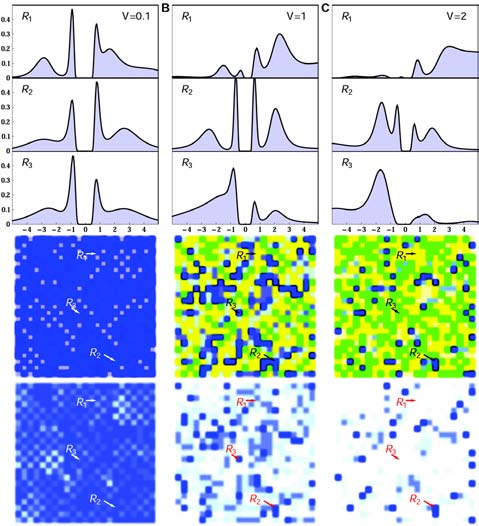below: Trivedi then calculated local density of states (top row), spatial local occupation (middle row) and local parameter order (bottom row) for increasing disorder (from left to right).
A superconductor is an amazing state of matter in which a macroscopic number of electrons pair up and condense into a coherent state exhibiting remarkable properties, such as zero resistance and perfect diamagnetism. Experiments suggest that upon tuning the film thickness or magnetic fields, there is an unusual phase transition from a superconductor to an insulator, driven by quantum effects.
“When a superconducting material is deposited as a thin film, it may behave as an insulator due to disorder and quantum fluctuations,” said Nandini Trivedi, Ph.D., a professor of physics at The Ohio State University. “There has been considerable theoretical work in the last decade, including our own work, on the superconductor-insulator transition (SIT), but many fundamental questions remain unanswered. These approaches have proved to be inadequate to capture the transition, let alone characterize the nature of the phases.”
According to one school of thought, electrons that are bound together at low temperatures – known as Cooper pairs – break apart, leading to a metallic phase near the SIT. An alternative viewpoint holds that the Cooper pairs remain bound and that the SIT is caused by phase fluctuations that destroy long-range phase coherence between superfluid patches.
Trivedi’s team is enlarging upon previous studies by including quantum and thermal phase fluctuations and calculating frequency-dependent quantities, such as the density of states. Whereas early experiments focused on the resistance of different films as a function of temperature, recent developments have allowed measurements of local and/or dynamical quantities.
“Quantum Monte Carlo (QMC) techniques are computationally expensive and require a high statistical accuracy in order to extract dynamical quantities via analytic continuation, but they are necessary for a unified explanation of the experiments,” she explained. “With the resources of the Ohio Supercomputer Center, we are able to conduct determinant QMC studies of the disorder-driven superconductor-insulator transition. By including thermal and quantum fluctuations we now can obtain a complete understanding of the superconductor, the insulator and the quantum phase transition.”
Previous studies conducted through the Ohio Supercomputer Center helped Trivedi to develop a phase diagram and show the emergence of a new type of insulator, different from previously known insulators. Now, her team is working to calculate for the first time the frequency-dependent conductivity and pair susceptibility – the tendency of pairs – as functions of disorder and temperature. Trivedi’s simulations include both thermal and quantum phase fluctuations, which are crucial to understanding some of the recent, puzzling experimental data showing low frequency absorption, well within the gap, in a disordered superconductor.
--
Project lead: Nandini Trivedi, The Ohio State University
Research title: Elucidating the role of quantum phase fluctuations across the disorder-driven superconductor-insulator transition
Funding source: National Science Foundation
Web site: www.physics.ohio-state.edu/~trivedi/
